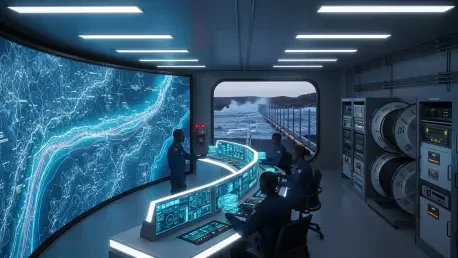Silent fibers and steel arteries on the UK seabed now carry the nation’s pulse, yet shadow fleets probe for weak seams while officials race to harden every mile. This roundup gathers viewpoints from naval planners, cable operators, insurers, and regional partners to gauge how London is reshaping policy, technology, and alliances to protect cables, interconnectors, and ports under rising geopolitical pressure.
From Quiet Cables to Contested Commons: Why The Seabed Now Matters
Energy executives describe a seabed crowded with power links and wind farm feeders that mesh with the data cables moving most global internet traffic. In their view, the map looks less like empty blue space and more like a dense utility grid, where a single break can ripple through markets, logistics, and public services.
Security officials argue that suspected interference—from the Russian vessel Yantar loitering near cables and allegedly using lasers against pilots, to unexplained trawler-like patterns near landing stations—has turned infrastructure into a frontline. Analysts note that Baltic cable cuts in 2024 foreshadowed a broader contest in the gray zone, where ambiguity slows response and emboldens risk.
Policy advisers contend that Britain’s course now runs through clarity: align fractured oversight, deploy smarter monitoring, and bind allies and markets into a sturdier deterrent. This article traces that shift and weighs how competing priorities—commerce, navigation, and defense—can still coexist at sea.
Inside The New Playbook To Shield Cables, Pipelines, And Ports
Shadow Fleets And Plausible Deniability At Sea
Naval officers describe shadow fleets as dual-use or lightly marked ships that masquerade as research, survey, or fishing vessels while mapping routes, spoofing signals, or testing defenses. Their method is patience: blend with routine traffic, keep intent opaque, and make any response look excessive.
Investigators point to a pattern of a dozen suspected interference incidents across recent years, the 2024 Baltic damage, and the Yantar episode that drew close Royal Navy shadowing. Moscow and Beijing deny state direction; maritime lawyers caution that deniability complicates both attribution and liability.
Strategists disagree on thresholds. Some favor firmer standoff zones and tighter escorts; others stress freedom of navigation and the escalatory risk of confronting vessels when evidence remains classified. The emerging consensus: raise costs through visibility, layered surveillance, and rapid, documented responses that withstand legal scrutiny.
Fixing The Whitehall Maze: Building Coherent Subsea Governance
Parliamentary voices, including MP Nick Timothy, warned that responsibility was split across ministries and agencies, leaving seams for adversaries. Cable consortia echoed that message, saying that diffuse authority slowed incident reporting and muddled tasking during alerts.
Officials now point to reforms. Minister Al Carns cited clearer lines of command, joint tasking across departments, and faster decision cycles, shifting from ad hoc fixes to a common operating picture that fuses naval, coastguard, and industry data.
Industry leaders welcome speed but highlight trade-offs: centralization accelerates action only if private operators, insurers, and port authorities are wired in. Funding rules, liability for shared patrols, and data-sharing protocols remain friction points that require predictable frameworks rather than case-by-case deals.
Sensors, Patrols, And Satellites: The Tech Stack For A Hidden Battlespace
Technologists outline a layered toolkit: seabed hydrophones, UAVs and USVs for persistent presence, AIS analytics to flag spoofing, satellite imagery to detect unusual patterns, and fiber-optic monitoring to sense tampering in real time. Insurers say such telemetry underwrites clearer risk models and faster claims decisions.
Commanders describe adaptive patrols near chokepoints, hardened landing stations, and red-team exercises that stress-test wind arrays and interconnectors. These drills surface mundane but decisive fixes—secure spares, redundant routes, and hardened power at coastal hubs.
Forward-looking teams push autonomous survey swarms, quantum-resilient links, and AI anomaly detection tailored to the North Sea’s crowded grid and the Atlantic’s deepwater stretches. The message is pragmatic: pair sophisticated detection with simple resilience measures that keep traffic flowing when alarms sound.
Allies, Insurers, And Operators: Aligning Incentives Beyond The Flag
Nordic-Baltic officials champion tight coordination on subsea surveillance, while others rely on looser, incident-driven cooperation. NATO’s focus on critical seabed infrastructure adds political weight, but private participation often determines speed at sea.
Market actors seek clearer incentives. Insurers are beginning to price interference risk, lenders are tying finance to resilience standards, and operators are adopting shared threat portals and joint incident drills to compress decision time. These shifts translate abstract warnings into balance-sheet realities.
Diplomats point to the road ahead: firmer norms on cable protection, meaningful penalties for interference, and “defend forward” partnerships that culminate in the Subsea Security Summit in May 2026. The yardstick will be whether these commitments produce faster detection, clearer attribution, and credible consequences.
What To Do Now: Hardening Plans For Government And Industry
Across interviews, several themes recur: threats are persistent, stealthy, and deniable; oversight is improving but uneven; and resilience depends on cross-border, cross-sector orchestration. The most effective programs blend national command with local execution and private accountability.
Practitioners recommend a national subsea coordination cell, mandatory rapid incident reporting, and multi-sensor surveillance near landing points. Standardized cable-route hardening and joint exercises that integrate Navy, Coastguard, and operators help move from paper protocols to muscle memory.
Developers of new wind projects are urged to deploy layered monitoring from day one, negotiate standing MOUs for rapid allied support, audit supply chains for survey and repair vessels, and pre-position spares to reduce outage windows. These are manageable steps that deliver outsized resilience.
Staying Power Below The Waves: What’s At Stake Next
Commentators traced a clear arc: wake-up calls like Yantar pushed London from fragmented oversight to an integrated, risk-informed defense of seabed lifelines. The goal is not to seal every mile, but to ensure attacks fail fast and recovery begins immediately.
They stressed that as data and energy dependence grows, deterrence and resilience must scale faster than adversary adaptation. That means aligning law, technology, markets, and alliances so that ambiguity favors defenders rather than spoilers at sea.
This roundup closed on practical next moves—codified reporting, shared sensing, credible penalties, and funded repair capacity—and suggested deeper reading in maritime law, cable engineering, and insurance modeling to keep progress grounded and measurable.









